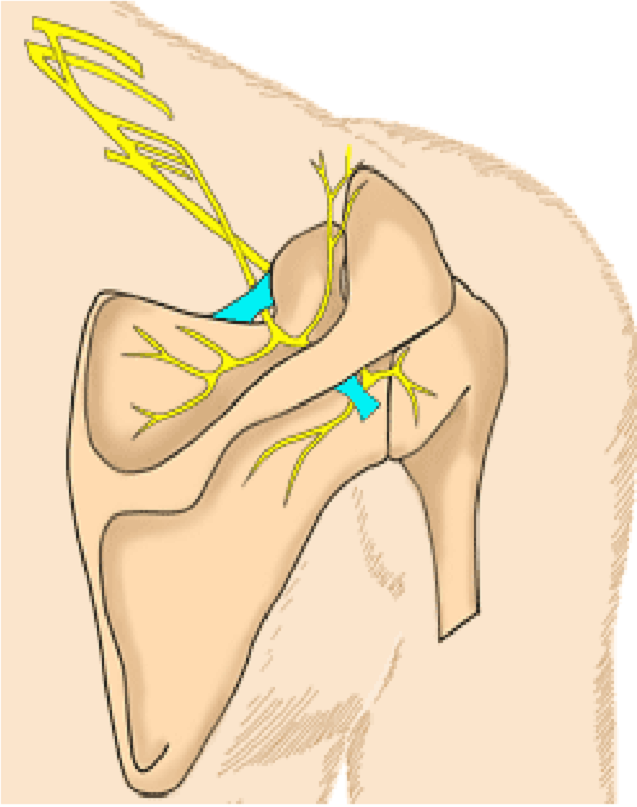Suprascapular nerve impingement
Suprascapular nerve – The nerve’s entrapment can be due to shoulder dysfunction or it can cause shoulder dysfunction. It supplies the supraspinatus and infraspinatus muscles. When they fail to function properly shoulder rhythm may be disrupted, resulting in various types of shoulder problems such as impingement syndrome. On the other hand, certain types of shoulder problems cause an improper scapulohumeral rhythm, stretching the suprascapular nerve with consequent neuropathy. Suprascapular nerve entrapment can cause a vicious circle in shoulder dysfunction.
The suprascapular nerve is derived from the upper trunk of the brachial plexus from the roots of C5 and C6. It passes down behind the brachial plexus parallel to the omohyoid muscle, traverses beneath the upper trapezius muscle to the superior edge of the scapula, and then through the suprascapular notch. The suprascapular notch is roofed by the transverse scapular ligament, creating a foramen. The suprascapular vessels cross above the foramen. Only occasionally the veins or maybe a branch of the suprascapular artery may run through the foramen. The nerve then supplies the supraspinatus muscle and provides articular branches to the glenohumeral and acromioclavicular joints. It supplies sensory and sympathetic fibers to two-thirds of the shoulder capsule. Usually there are no sensory fibers to the skin. The nerve then winds around the base of the scapular spine to supply the infraspinatus muscle. In about 50% of people there is another connective tissue band creating a second fibro-osseous opening for the nerve to traverse.
Suprascapular Nerve Stretch Suprascapular nerve dysfunction can develop from nerve compression at either fibro-osseous tunnel or from stretching of the nerve. In normal shoulder activity the scapula has a wide range of motion; the nerve must be able to adapt, or entrapment or stretching of the nerve develops. Few nerves are required to have the flexibility to adapt to such a wide range of motion. The most common cause of increased strain on the nerve is poor scapulohumeral rhythm. Occupations that require a lot of overhead work or other activities that place the arm at extremes of abduction and/or external rotation predispose a person to this nerve entrapment. Less common is stenosis at one of the fibro-osseous foramen by a cyst or osseous entrapment.
Symptoms:
The main symptom of suprascapular nerve entrapment is deep and diffuse pain poorly localized in the posterior and lateral aspects of the shoulder. The pain is common with many other shoulder problems, making the condition difficult to diagnosis without the aid of applied kinesiology testing. Pain may be referred to the neck, into the arm, or generally to the upper anterior chest, but localized to the acromioclavicular joint. The radial and suprascapular nerves have common root origins with an overlap of radiation down the radial nerve to the region of the common extensor group. Scapular motion aggravates the pain. Usually the patient says that shoulder motion causes the pain, but it is scapular motion and not actually glenohumeral motion that does so.
Examination:
Increased pain can usually be elicited by the examiner applying digital pressure to the supraspinatus muscle in the general region of the suprascapular notch. In chronic conditions there may be atrophy of the supra- and/or infraspinatus muscles.
Treatment:
Conservative treatment in applied kinesiology is directed toward obtaining normal function of the shoulder complex. This requires that all five joints of the shoulder complex be examined. Common problems are subluxations and disrupted temporal patterns of muscle contraction and/or inhibition. The most common suprascapular nerve problem is excessive scapula protraction and/or rotation that stretches the nerve. This is indicated by previously strong supraspinatus and/or infraspinatus muscles weakening when tested with scapula motion such as protraction. If there is excess scapula motion the patient should be evaluated for anterior cervical subluxation and dorsal scapula nerve entrapment. The anterior cervical subluxation is important because it is often associated with short or hypertonic scalene muscles setting the stage for dorsal scapula nerve entrapment. The dorsal scapula nerve supplies the rhomboid muscles that are major stabilizers in scapula protraction.
Shoulder girdle function and its relation to the thoracic outlet syndrome should also be considered.
If conservative treatment fails, further evaluation of the suprascapular nerve for peripheral entrapment is necessary. Further diagnostic work can by done with electrodiagnosis with needle electrodes or by magnetic resonance imaging (MRI). Surgical release consists of excising the suprascapular ligament.

